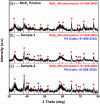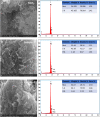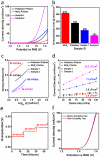An advanced PdNPs@MoS2 nanocomposite for efficient oxygen evolution reaction in alkaline media
- PMID: 37928849
- PMCID: PMC10623383
- DOI: 10.1039/d3ra04738e
An advanced PdNPs@MoS2 nanocomposite for efficient oxygen evolution reaction in alkaline media
Abstract
In response to the increasing availability of hydrogen energy and renewable energy sources, molybdenum disulfide (MoS2)-based electrocatalysts are becoming increasingly important for efficient electrochemical water splitting. This study involves the incorporation of palladium nanoparticles (PdNPs) into hydrothermally grown MoS2via a UV light assisted process to afford PdNPs@MoS2 as an alternative electrocatalyst for efficient energy storage and conversion. Various analytical techniques, including scanning electron microscopy (SEM), transmission electron microscopy (TEM), X-ray diffraction (XRD), X-ray photoelectron spectroscopy (XPS), and energy dispersive spectroscopy (EDS), were used to investigate the morphology, crystal quality, and chemical composition of the samples. Although PdNPs did not alter the MoS2 morphology, oxygen evolution reaction (OER) activity was driven at considerable overpotential. When electrochemical water splitting was performed in 1.0 M KOH aqueous solution with PdNPs@MoS2 (sample-2), an overpotential of 253 mV was observed. Furthermore, OER performance was highly favorable through rapid reaction kinetics and a low Tafel slope of 59 mV dec-1, as well as high durability and stability. In accordance with the electrochemical results, sample-2 showed also a lower charge transfer resistance, which again provided evidence of OER activity. The enhanced OER activity was attributed to a number of factors, including structural, surface chemical compositions, and synergistic effects between MoS2 and PdNPs.
This journal is © The Royal Society of Chemistry.
Conflict of interest statement
Authors declare no conflict of interest in this research work.
Figures







References
-
- Wu M. Meng X. Zhou M. Zhou Y. New J. Chem. 2023;47:9492–9500.
-
- Hou X. Zhou H. Zhao M. Cai Y. Wei Q. ACS Sustain. Chem. Eng. 2020;8:5724–5733.
-
- Zhang L. Xiao J. Wang H. Shao M. ACS Catal. 2017;7:7855–7865.
-
- Joseph N. Shafi P. M. Bose A. C. Energy Fuels. 2020;34:6558–6597.
LinkOut - more resources
Full Text Sources
Research Materials

